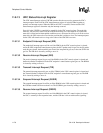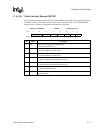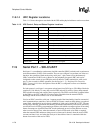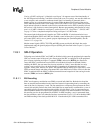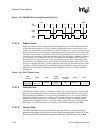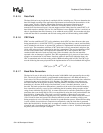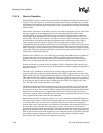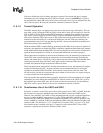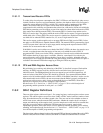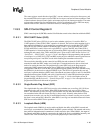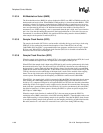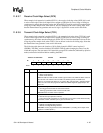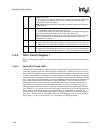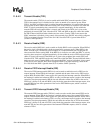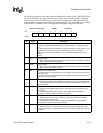
11-84 SA-1100
Developer’s Manual
Peripheral Control Module
11.9.1.11 Transmit and Receive FIFOs
To reduce chip size and power consumption, the SDLC’s FIFOs use self-timed logic (they are not
clocked). Because of process and environmental variations, the depth at which a service request is
triggered to empty the receive FIFO is variable. This variation spans a maximum of four FIFO
entries; the receive FIFO service request can be made at four different FIFO depths. To
compensate for this variability and guarantee that at least four valid entries of data exist within the
FIFO before generating a service request, an extra four entries have been added to the receive FIFO
(four entries more than the transmit FIFO). The transmit FIFO is 8 entries deep and the receive
FIFO is 12 entries deep. The point at which the receive FIFO service request is triggered spans the
middle third of the 12-entry FIFO. The service request is signalled at a depth from one-third full to
two-thirds full or when the FIFO contains five, six, seven, or eight entries of data.
This service request variation applies only to an empty FIFO that is filled (receive FIFO). It does
not apply to a full FIFO that is emptied (transmit FIFO). The transmit FIFO is guaranteed to signal
a service request when it has four or more empty entries and negate the request when the FIFO
contains five or more entries that are filled.
If the DMA is used to service either one or both of the SDLC’s FIFOs, the burst size must be set to
4 words, even though more than four entries of data may exist within the receive FIFO. If
programmed I/O is used to service the FIFOs, a maximum of 4 words may be added to the transmit
FIFO without checking if more space is available. Likewise, a maximum of 4 words may be
removed from the receive FIFO without checking if more data is available. After this point, the
user must poll a set of status bits that indicate if any data remains in the receive FIFO or if space is
available in the transmit FIFO before emptying or filling the FIFOs any further.
11.9.1.12 CPU and DMA Register Access Sizes
Bit positioning, byte ordering, and addressing of the SDLC is described in terms of little endian
ordering. All SDLC registers are 8 bits wide and are located in the least significant byte of
individual words. The ARM
peripheral bus does not support byte or half-word operations. All
reads and writes of the SDLC by the CPU should be wordwide. Two separate dedicated DMA
requests exist for both the transmit and the receive FIFOs. If the DMA controller is used to service
the transmit and/or receive FIFOs, the user must ensure that the DMA is properly configured to
perform byte-wide accesses, using 4 bytes per burst (half the size of the FIFOs). Note that a
separate set of registers also exist to configure UART operation.
See the Section 11.9, “Serial Port 1 – SDLC/UART” on page 11-78 for a full description of
programming and the operation of serial port 1 as a UART.
11.9.2 SDLC Register Definitions
There are eight registers within serial port 1: five control registers, one data register, and two status
registers. The control registers are used to select UART or SDLC mode, baud rate, number of start
flags, bit modulation mode, and address match value. They are used to select whether an abort or
end of frame occurs when the transmit FIFO underruns, whether the sample clock is an input or
output, and which edge of the sample clock is used to sample receive data and drive transmit data.
Also they are used to enable or disable the FIFO interrupt service request, sample clock
input/output operation, aborts after frames, receive operation, transmit operation, receive address
matching, and loopback mode. See the Section 11.9, “Serial Port 1 – SDLC/UART” on page 11-78
for a full description of UART programming and operation.
The data register addresses the top location of the transmit FIFO and bottom location of the receive FIFO.
When it is read, the receive FIFO is accessed, and when it is written, the transmit FIFO is accessed.



